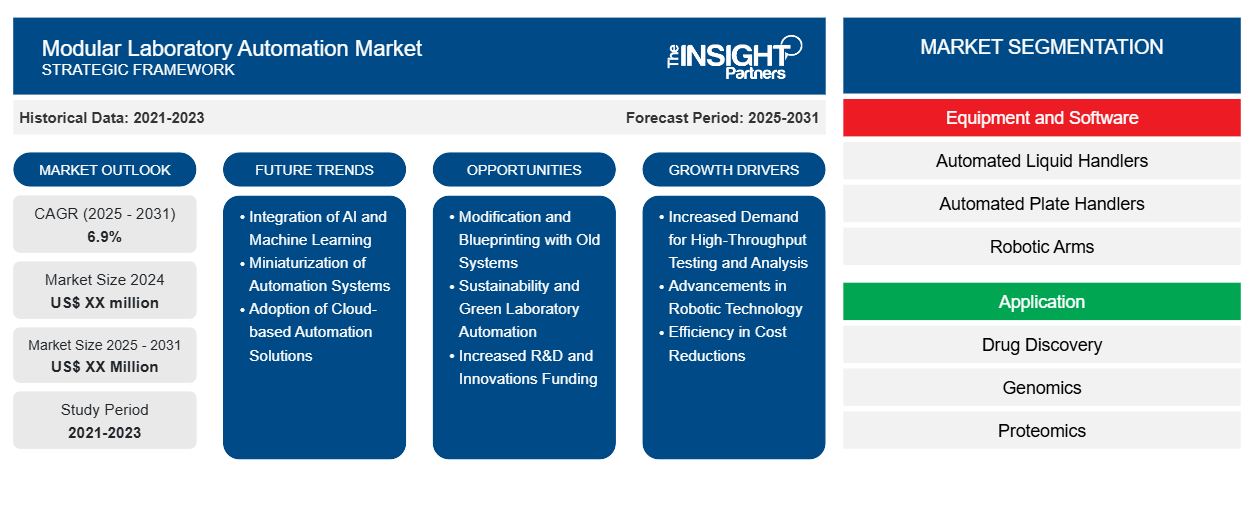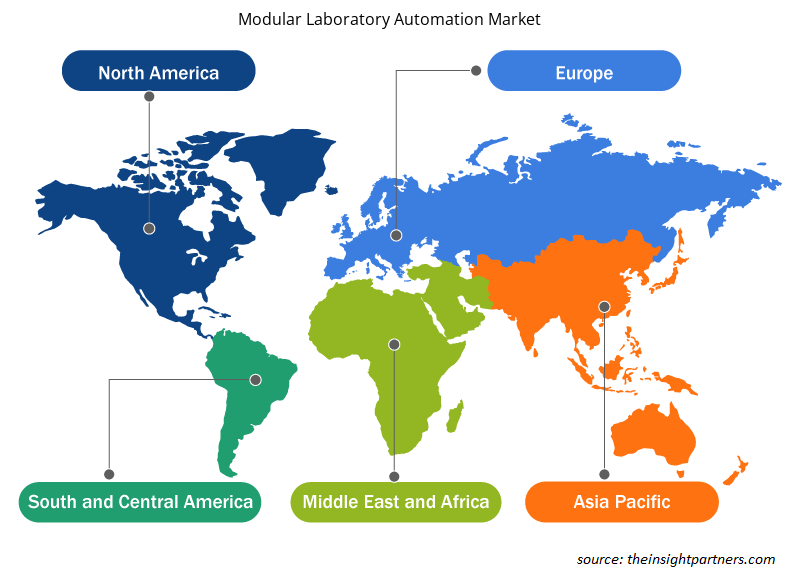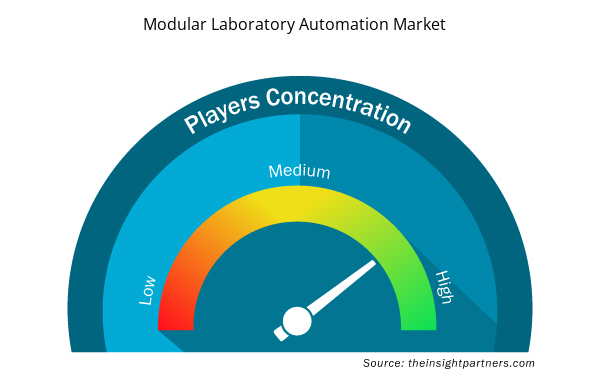The Modular Laboratory Automation Market is expected to register a CAGR of 6.9% from 2025 to 2031, with a market size expanding from US$ XX million in 2024 to US$ XX Million by 2031.
The report is segmented by Equipment and Software (Automated Liquid Handlers, Automated Plate Handlers, Robotic Arms, Automated Storage and Retrieval Systems (ASRS), Software, Analyzers). The report further presents analysis based on the Application (Drug Discovery, Genomics, Proteomics, Clinical diagnostics). The global analysis is further broken-down at regional level and major countries. The Report Offers the Value in USD for the above analysis and segments.
Purpose of the Report
The report Modular Laboratory Automation Market by The Insight Partners aims to describe the present landscape and future growth, top driving factors, challenges, and opportunities. This will provide insights to various business stakeholders, such as:
- Technology Providers/Manufacturers: To understand the evolving market dynamics and know the potential growth opportunities, enabling them to make informed strategic decisions.
- Investors: To conduct a comprehensive trend analysis regarding the market growth rate, market financial projections, and opportunities that exist across the value chain.
- Regulatory bodies: To regulate policies and police activities in the market with the aim of minimizing abuse, preserving investor trust and confidence, and upholding the integrity and stability of the market.
Modular Laboratory Automation Market Segmentation
Equipment and Software
- Automated Liquid Handlers
- Automated Plate Handlers
- Robotic Arms
- Automated Storage and Retrieval Systems
- Software
- Analyzers
Application
- Drug Discovery
- Genomics
- Proteomics
- Clinical diagnostics
Customize This Report To Suit Your Requirement
You will get customization on any report - free of charge - including parts of this report, or country-level analysis, Excel Data pack, as well as avail great offers and discounts for start-ups & universities
Modular Laboratory Automation Market: Strategic Insights

- Get Top Key Market Trends of this report.This FREE sample will include data analysis, ranging from market trends to estimates and forecasts.
Modular Laboratory Automation Market Growth Drivers
- Increased Demand for High-Throughput Testing and Analysis: A laboratory now faces increasing demands from research with the high volume of data and high-throughput testing. Research has become complicated with personalized medicine and has spread into many fields of biotechnology, and faster testing needs increasement in accuracy. Modular laboratory automation systems prove to be capable of handling high-throughput demand and help increase productivity in the laboratory by reducing repetitive actions and overall processing time. Automating the activities such as sample preparation, analysis, and data collection ensures that these bring out the high-throughput laboratories in meeting the increasing results speed and accuracy demand, creating room for their growth.
- Advancements in Robotic Technology: Integration of the most advanced robotic technology has been perhaps the most important engine that drives modular laboratory automation. Increasingly, robotic equipment is assigned to automating the most common laboratory chores such as pipetting, sorting, and sample handling. Such systems have very easy customization and hence easily adapt to a wide spectrum of laboratory operations, thus allowing an increase in efficiency and precision. The advancements in the realms of artificial intelligence and ML have also further widened what can be done with robotics, now more capable of solving more complex tasks with an amount of precision much bigger than earlier. All of these innovations allow modular automation systems to provide a diverse array of solutions through other industries, pharmaceuticals among them; health care; and life sciences.
- Efficiency in Cost Reductions: The necessity for modular laboratory automation comes on the heels of a demand for reducing operational costs and enhancing efficiency in those same operations. In spite of the cost of an automated system when first installing it, this sort of solution tends to lower the long-term cost of running logic through better efficiency in workflow along with lowered errors due to human judgment. End automated systems eliminate the need for manual intervention, thus reducing labor costs and the risk of really expensive mistakes in sensitive processes. Modular space solutions become more and more attractive as improvements in productivity are made while costs are lowered in operations.
Modular Laboratory Automation Market Future Trends
- Integration of AI and Machine Learning: This is what the future brings with the coalescence of artificial intelligence and machine learning, as they help transform the modular laboratory automation space. The uses of these technologies are toward the optimization of laboratory processes, such as in data analysis, predictive maintenance, and decision-making. Artificial Intelligence systems can help automate mundane duties, distinguish between data elements that are not seen by human eyes, and predict the outputs of experiments based on historical data. This trend can thus be expected because such advances will surely lead to increasingly streamlined laboratory processes with reduced errors.
- Miniaturization of Automation Systems: The miniaturization of modular automation solutions is emerging as one of the major trends because more laboratory users demand their systems to compact, versatile module. Smaller and more flexible devices are also easier to fit into existing lab arrangements and are beneficial especially in places with limited space. Bringing about miniaturization, automation systems are more accessible to smaller labs; remove contamination and error by handling small samples with increased precision. This trend is especially relevant in biotechnology because sample manipulation often entails working with minute amounts of reagents and samples.
- Adoption of Cloud-based Automation Solutions: Cloud Computing is redefining the automation paradigm for laboratories. Most of modular systems nowadays already have cloud-ready functions. Many now allow remote monitoring of units, associated data management, and cooperation across different research teams in various locations. Cloud-based options to consider would be for more open modes of integrating diverse instruments and software to build one big automation system. Thus, it can obtain benefits in terms of flexibility and scalability.
Modular Laboratory Automation Market Opportunities
- Modification and Blueprinting with Old Systems: Customization in the automation market extends to modular automations fitting into existing laboratory layouts. Most laboratories are averse to full replacement of their legacy equipment, even though such equipment is too costly to replace. It would not necessarily mean that laboratories are not taking into consideration into the recognition of such need, from companies, whom they will be most likely looking to satisfy, demands for such solutions. Common choices in this regard have been modular automation systems keeping pace with antiquated systems, customization options such as user-friendly interfaces, as well as integrations with specific software.
- Sustainability and Green Laboratory Automation: As their personalities are more environmentally friendly, there will be growing movements toward the adoption of more sustainable, energy-efficient automation. The development of modular automation systems with waste minimizers, which consume less energy and depend significantly less on consumables, creates very huge potentials in this area. Because of this, sustainability is growing in importance among research institutions and commercial laboratories; as a result, more and more demand will be presented by players who offer such solutions into the market.
- Increased R&D and Innovations Funding: Yet again, there is opportunity for most players as the modular laboratory automation market is under continuous investment in research and development. Therefore, as demand rises toward more sophisticated and efficient systems, organizations that prioritize investments within their R&D arms in the development of new features will remain competitively ahead through flexibility and the latest technological advancements.
Modular Laboratory Automation Market Regional Insights
The regional trends and factors influencing the Modular Laboratory Automation Market throughout the forecast period have been thoroughly explained by the analysts at Insight Partners. This section also discusses Modular Laboratory Automation Market segments and geography across North America, Europe, Asia Pacific, Middle East and Africa, and South and Central America.

- Get the Regional Specific Data for Modular Laboratory Automation Market
Modular Laboratory Automation Market Report Scope
| Report Attribute | Details |
|---|---|
| Market size in 2024 | US$ XX million |
| Market Size by 2031 | US$ XX Million |
| Global CAGR (2025 - 2031) | 6.9% |
| Historical Data | 2021-2023 |
| Forecast period | 2025-2031 |
| Segments Covered |
By Equipment and Software
|
| Regions and Countries Covered | North America
|
| Market leaders and key company profiles |
Modular Laboratory Automation Market Players Density: Understanding Its Impact on Business Dynamics
The Modular Laboratory Automation Market market is growing rapidly, driven by increasing end-user demand due to factors such as evolving consumer preferences, technological advancements, and greater awareness of the product's benefits. As demand rises, businesses are expanding their offerings, innovating to meet consumer needs, and capitalizing on emerging trends, which further fuels market growth.
Market players density refers to the distribution of firms or companies operating within a particular market or industry. It indicates how many competitors (market players) are present in a given market space relative to its size or total market value.
Major Companies operating in the Modular Laboratory Automation Market are:
- Thermo Fisher Scientific
- Danaher Corporation
- Hudson Robotics, Inc
- Becton Dickinson
- Siemens Healthcare
Disclaimer: The companies listed above are not ranked in any particular order.

- Get the Modular Laboratory Automation Market top key players overview
Key Selling Points
- Comprehensive Coverage: The report comprehensively covers the analysis of products, services, types, and end users of the Modular Laboratory Automation Market, providing a holistic landscape.
- Expert Analysis: The report is compiled based on the in-depth understanding of industry experts and analysts.
- Up-to-date Information: The report assures business relevance due to its coverage of recent information and data trends.
- Customization Options: This report can be customized to cater to specific client requirements and suit the business strategies aptly.
The research report on the Modular Laboratory Automation Market can, therefore, help spearhead the trail of decoding and understanding the industry scenario and growth prospects. Although there can be a few valid concerns, the overall benefits of this report tend to outweigh the disadvantages.
- Historical Analysis (2 Years), Base Year, Forecast (7 Years) with CAGR
- PEST and SWOT Analysis
- Market Size Value / Volume - Global, Regional, Country
- Industry and Competitive Landscape
- Excel Dataset



Report Coverage
Revenue forecast, Company Analysis, Industry landscape, Growth factors, and Trends

Segment Covered
This text is related
to segments covered.

Regional Scope
North America, Europe, Asia Pacific, Middle East & Africa, South & Central America

Country Scope
This text is related
to country scope.
Frequently Asked Questions
Automated Liquid Handlers segment, by Equipment and Software, dominated the market in 2023.
Players operating in the market are Thermo Fisher Scientific, Danaher Corporation, Hudson Robotics, Inc, Becton Dickinson, Siemens Healthcare, BD, Agilent Technologies, Synchron Lab Automation, Tecan Group
North America region dominated the Modular Laboratory Automation market in 2023.
Modification and Blueprinting with Old Systems act as a opportunity for growth of the market in forecast period.
The Modular Laboratory Automation Market is estimated to witness a CAGR of 6.9% from 2023 to 2031
The major factors driving the Modular Laboratory Automation market are:
1. Increased Demand for High-Throughput Testing and Analysis
2. Advancements in Robotic Technology
Trends and growth analysis reports related to Life Sciences : READ MORE..
1. Thermo Fisher Scientific
2. Danaher Corporation
3. Hudson Robotics, Inc
4. Becton Dickinson
5. Siemens Healthcare
6. BD
7. Agilent Technologies
8. Synchron Lab Automation
9. Tecan Group
10. PerkinElmer

 Get Free Sample For
Get Free Sample For